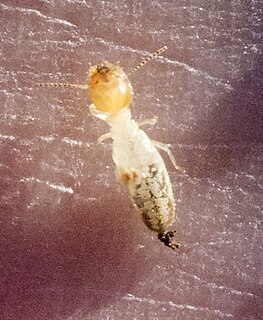Michael S. Engel, FLS, FRES is an American paleontologist and entomologist, notable for contributions to insect evolutionary biology and classification. In connection with his studies he has undertaken field expeditions in Central Asia, Asia Minor, the Levant, Arabia, eastern Africa, the high Arctic, and South and North America, and has published more than 860 papers in scientific journals and over 925 new living and fossil species. Some of Engel's research images were included in exhibitions on the aesthetic value of scientific imagery. Engel is the author of Innumerable Insects and co-author of Evolution of the Insects.

Mastotermitidae is a family of termites with one sole living species, Mastotermes darwiniensis which is found only in northern Australia. The remaining genera of this family are only known from the fossil record.
Termopsidae is an extinct family of termites in the order Blattodea. The five extant genera formerly included in Termopsidae have recently been treated as part of the newer family Archotermopsidae, leaving only extinct taxa in Termopsidae.
Ceylonitermes escherichi is a species of termite. It is endemic to Sri Lanka.

Archotermopsidae is a family of termites in the order Blattodea, known as dampwood termites, formerly included within the family Termopsidae. They constitute a small and rather primitive family with five extant genera and 13–20 living species. They may be a nuisance, but compared to the drywood termites (Kalotermitidae), usually do not cause extensive damage to buildings or other man-made structures. As their name implies, they eat wood that is not dried out, perhaps even rotting, and consequently of little use to humans.

Zootermopsis laticeps, known generally as Arizona dampwood termite, is a species of termite in the family Archotermopsidae. Other common names include the wide-headed rottenwood termite and southwestern rottenwood termite. It is found in arid parts of south-western North America.

Gnathamitermes perplexus, the long-jawed desert termites, is a species of termite in the family Termitidae. It is found in Central America and North America.

Gnathamitermes is a genus of termites in the family Termitidae. There are about six described species in Gnathamitermes.
Reticulitermes hageni, the light southeastern subterranean termite, is a species of termite in the family Rhinotermitidae. It is found in North America.

Reticulitermes hesperus, the western subterranean termite, is a species of termite in the family Rhinotermitidae. It is found in Central America and North America.
Neotermes castaneus, known generally as the southern damp-wood termite or Florida dampwood termite, is a species of termite in the family Kalotermitidae. It is found in the Caribbean Sea, Central America, North America, and South America.
Marginitermes hubbardi, commonly known as the light western drywood termite, is a species of termite in the family Kalotermitidae. It is found in Central America and desert regions of southwestern North America.
Marginitermes is a genus of termites in the family Kalotermitidae. There are at least three described species in Marginitermes.
Tenuirostritermes cinereus is a species of termite in the family Termitidae. It is found in Central America and North America.
Tenuirostritermes is a genus of termites in the family Termitidae. There are about five described species in Tenuirostritermes.
Kumar Krishna was an American entomologist of Indian origin. He was an expert on the termites and published the definitive systematic treatment of the termites of the world in a seven volume Treatise on the Isoptera of the world in 2013 written with collaborators.

Stylotermitidae is a family of termites in the order Blattodea. There are two extinct and one extant genera in Stylotermitidae, with more than 50 described species.

Hospitalitermes is an Indomalayan genus of lichen eating termite in the subfamily Nasutitermitinae. There are 37 species currently listed, of which most are recognized for their extensive surface foraging columns. Due to their conspicuous foraging activities they are commonly known as processionary or marching termites. They often inhabit cavities inside of living trees excavated by other species of termite.
Archeorhinotermes is an extinct genus of termites in the family Archeorhinotermitidae, and is the sole genus of the family. There is one described species in Archeorhinotermes, A. rossi. It was discovered in Burmese amber.
Cratomastotermes is an extinct genus of termites in the family Cratomastotermitidae, the sole genus of the family. There is one described species in Cratomastotermes, C. wolfschwenningeri.








